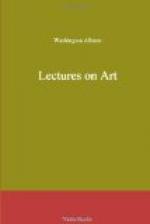But the desire in question is not confined to any particular age or temperament, though it is, doubtless, more ardent in some than in others. Perhaps it is only denied to the habitually vicious. For who, not hardened by vice, has ever looked upon a sleeping child in its first bloom of beauty, and seen its pure, fresh hues, its ever varying, yet according lines, moulding and suffusing, in their playful harmony, its delicate features,—who, not callous, has ever looked upon this exquisite creature, (so like what a poet might fancy of visible music, or embodied odors,) and has not felt himself carried, as it were, out of this present world, in quest of its moral counterpart? It seems to us perfect; we desire no change,—not a line or a hue but as it is; and yet we have a paradoxical feeling of a want,—for it is all physical; and we supply that want by endowing the child with some angelic attribute. Why do we this? To make it a whole,—not to the eye, but to the mind.
Nor is this general disposition to find a coincidence between a fair exterior and moral excellence altogether unsupported by facts of, at least, a partial realization. For, though a perfect correspondence cannot be looked for in a state where all else is imperfect, he is most unfortunate who has never met with many, and very near, approximations to the desired union. But we have a still stronger assurance of their predetermined affinity in the peculiar activity of this desire where there is no such approximation. For example, when we meet with an instance of the higher virtues in an unattractive form, how natural the wish that that form were beautiful! So, too, on beholding a beautiful person, how common the wish that the mind it clothed were also good! What are these wishes but unconscious retrospects to our primitive nature? And why have we them, if they be not the workings of that universal law, which gathers to itself all scattered affinities, bodying them forth in the never-ending forms of harmony,—in the flower, in the tree, in the bird, and the animal,—if they be not the evidence of its continuous, though fruitless, effort to evolve too in man its last consummate work, by the perfect confluence of the body and the spirit? In this universal yearning (for it seems to us no less) to connect the physical with its appropriate moral,—to say nothing of the mysterious intuition that points to the appropriate,—is there not something like a clew to what was originally natural? And, again, in the never-ceasing strivings of the two great elements of our being, each to supply the deficiencies of the other, have we not also an intimation of something that once was, that is now lost, and would be recovered? Surely there must be more in this than a mere concernment of Art;—if, indeed, there be not in Art more of the prophetic than we are now aware of. To us it seems that this irrepressible desire to find the good in the beautiful, and the beautiful in the good, implies an




